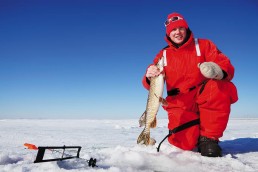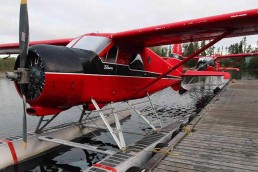Inside Tips for Great Michigan Fishing
Michigan experienced a weird winter this year, and many folks are counting down the days to spring fishing. As the snow and ice continue to melt, many anglers will be readying their boats, rods and tackle as they itch to get out on the water. Here’s what many will be looking for this April and May in a few key parts of the state.
Statewide opportunities for panfish
Inland lakes will provide ideal locations to target these species. For lakes that have a darker stained color (from dissolved organic material), they’ll warm up faster and see earlier fish-feeding activity. When on these waters anglers should pay attention to areas of the lake where the sun is beating the most, as these will warm quickly and fish will gravitate to these warmer areas.
Muskellunge, Northern pike, Walleyes
These predatory species can’t be fished until the season opens on Saturday, April 30. Both muskies and pike can be tough to catch when temperatures are very cool, and anglers should use smaller baits and fish with a slower retrieve until things warm up.
For predatory fish, pay close attention to drop-offs in inland lakes. Often, these species will hang out in deeper water and come in to feed on the baitfish swimming in shallower areas.
Trout, Salmon
In April, steelhead will start to move through the lower tributaries of Lake Michigan. Visit any pier (such as the St. Joseph River) and you’ll have a good chance of landing one of these. Coho salmon will be one of the first to arrive on the scene as the temperatures warm up. Anglers will often troll near the shore or high in the water column offshore to find these salmon.
Local opportunities:
Lake Gogebic, Western Upper Peninsula
Lake Gogebic offers good opportunities for spring walleyes and perch. This lake is noted for its nearshore fishery for spring walleyes. New sport fishing regulations at Lake Gogebic allow anglers the option of keeping two walleyes—13 inches up to 15 inches—within their five-fish daily possession limit. Smallmouths and northern pike also offer exciting catches. Motels, restaurants, bait shops and boat rentals provide all the necessities for visitors to this 13,000-acre lake. Additional fishing opportunities exist for brook trout in the streams near Lake Gogebic, as well as at Porcupine Mountain State Park located 15 miles north on the shore of Lake Superior.
Tahquamenon River, Eastern Upper Peninsula
Primarily known for its muskellunge fishery, the Tahquamenon River offers a variety of opportunities for a variety of anglers. Starting in the upper reaches above McMillan, trout anglers can fish for brook trout in a population that offers high numbers of fish. Moving downstream, anglers can target northern pike, muskellunge and yellow perch in the Dollarville Flooding just upstream of Newberry.
In the section between Newberry and the Upper Falls, anglers boast how incredible the muskie fishery is at offering high catch rates. Also, yellow perch and walleyes can be caught along the edges of the deeper pools and downed trees. Between the Upper and Lower Falls, the Michigan Department of Natural Resources annually stocks brown trout. Here, anglers can target brown trout in the rapids just upstream from the Lower Falls. Muskies are also a popular target here. Moving below the Lower Falls in Chippewa County, walleyes and yellow perch are popular during the entire open-water season. Deep water in this reach can be a challenge, but anglers are successful when they can find vegetation and the right structure. Boating access sites can be found at the Dollarville Flooding and McPhee’s Landing near Newberry. Tahquamenon Falls State Park also has a boat launch at the Rivermouth Campground to access the river below the falls. Overall, the Tahquamenon River offers a little bit for every type of angler on a beautiful and unique setting in the Eastern Upper Peninsula.
Brevet Lake, Mackinac County
Brevort Lake is located in central Mackinac County, approximately 15 miles northwest of St. Ignace. It is 4,300 acres and has a relatively uniform bathymetry with a maximum depth of about 25 feet. It is a great spot for anglers to try with primary summer sport fisheries including walleyes, panfish, smallmouths and northern pike. Principle prey species include yellow perch, white sucker, common shiner, bluntnose minnow, golden shiner and crayfish.
Union Lake, southeast Michigan
Union Lake is located in central Oakland County about six miles west of Pontiac and three miles south of Highland Road (M-59). This is a 465-acre lake with a state boat launch that has parking for 33 vehicles and trailers. The fishery is diverse and includes good-sized bluegills up to 10 inches, smallmouth and largemouth bass up to 4 or 5 pounds, yellow perch and walleyes. The walleye fishery is maintained through the stocking of about 50,000 fingerlings every other year and anglers have fair success trolling or casting for them along the steep drop-offs. Bluegills and other panfish are found near beds of vegetation in the shallow areas next to the deeper areas. Bass are caught everywhere using live bait or lures in depths ranging from 1 foot of water under docks to weed beds and shallow flats in 4 to 6 feet as well as deeper areas along the drop-offs. After mid-May the recreational boat traffic can be very heavy on weekends, so fishing early in the morning or during the week is recommended later in the summer.
St. Joseph River, southwest Michigan
The St. Joseph River in Berrien County is one of the best steelhead rivers in southern Michigan. Due to the construction of fish ladders at five hydroelectric dams, the portion of the river that is accessible to steelhead extends from the mouth at the twin cities of St. Joseph and Benton Harbor, to upstream to Mishawaka, Ind. Although some steelhead are present in the river nearly year-round, they are most abundant in the here during spring spawning runs in March to mid-April. Numerous boat launches and parks provide public access to the river. Popular fishing locations include the stream reaches immediately below the Berrien Springs, Buchanan and Niles (French Paper) dams. The lower Dowagiac River, which flows in the St. Joseph River at Niles, also supports a strong steelhead fishery.
Les Cheneaux Islands, Lake Huron
Fishing is plentiful throughout the 36 islands that make up the Les Cheneaux Islands. Yellow perch and northern pike populations have rebounded considerably here and anglers can now harvest splake thanks to new fishing regulations. All of these species can be found in the early season and provide lots of fun for those who target them.
The Burt and Mullett, northeast Michigan
The Burt and Mullett lakes are the main sources for the Inland Waterway, located in Cheboygan County. In fact, the town of Indian River is the heart of the Inland Waterway.
Mullett Lake is 17,360 acres and anglers can expect great spring fishing for bluegills, trout and northern pike. Burt Lake is 17,120 acres, with 73 feet at its deepest part. As with Mullett Lake, Burt Lake is excellent for trout, bluegills and northern pike.
Start planning your spring and early summer trip today, but don’t forget to purchase your license before you head out. The 2016 Michigan fishing licenses went on sale in March. Don’t miss your chance to experience the endless fishing opportunities in this state. For more information, visit michigan.gov/fishing.
MWO
SHARE THIS POST
Did you enjoy this post?
You can be among the first to get the latest info on where to go, what to use and how to use it!
MWO
We believe being outdoors is good. With more than 1,000 articles each year, MidWest Outdoors magazine is all about sharing outdoor experiences with you—where to go, what to use and how to use it… whether you’re close to home or on that trip of a lifetime.



